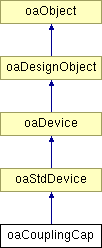 |
 |
 |
||||||
Inheritance diagram for oaCouplingCap:

 |
 |
Public Methods | |
| oaBoolean | isLocal () const |
| oaBoolean | isOtherConn () const |
| oaNode * | getNode (oaEndpointType endpoint) const |
| oaNode * | getOtherNode (oaNode *node) const |
| void | getOtherNode (oaDesignObject *&otherNet, oaUInt4 &otherNodeId) const |
| oaDesignObject * | getOtherConn () const |
Static Public Methods | |
| oaCouplingCap * | create (oaNode *fromNode, oaNode *toNode) |
| oaCouplingCap * | create (oaNode *fromNode, oaNode *toNode, oaUInt4 id) |
| oaCouplingCap * | create (oaNode *fromNode, oaDesignObject *otherNet, oaUInt4 otherNodeId, oaUInt4 id) |
| oaCouplingCap * | create (oaNode *fromNode, oaDesignObject *otherConn, oaUInt4 id) |
A coupling capacitor between two nodes in the same parasitic network is considered a local coupling cap. Local coupling caps have a single representation in the database. When a coupling capacitor physically connects two different parasitic networks, it is represented in the database as two distinct devices, one within each parasitic network. This allows each parasitic network to be loaded independently and efficiently.
The from endpoint of a oaCouplingCap always connects to a node in the same parasitic network as the oaCouplingCap itself. For local coupling caps, the to endpoint also connects to a node in the same parasitic network.
For coupling caps that connect nodes in two different networks, the nodes in both networks must be assigned a unique ID when the nodes are created. The net and the node ID are used to specify the node to which the to endpoint of each oaCouplingCap connects.
For coupling caps that connect a node in one parasitic network and an instTerm or term in a different network, the node must be assigned a unique ID when it is created. The oaDesignObject for the connection is used to specify the to endpoint of the oaCouplingCap. The isOtherConn() function must be used to distinguish between this type of coupling capacitor and coupling caps between nodes in different networks.
|
||||||||||||||||
|
This function creates a coupling capacitor in the fromNode parasitic network that couples between fromNode and an instTerm or term in the parasitic network for another net. The parasitic network for the other net does not have to exist or be in memory at the time that this function is called.
|
|
||||||||||||||||||||
|
This function creates a coupling capacitor in the fromNode parasitic network that couples between fromNode and a node in the parasitic network for another net. The parasitic network for otherNet does not have to exist or be in memory at the time that this function is called. The otherNodeId specifies a unique ID for the node in the otherNet parasitic network, and that ID must be specified when the node is created. The coupled nets must be within a given hierarchy domain, either oaNets or oaOccNets.
|
|
||||||||||||||||
|
This function creates a local coupling capacitor between the specified nodes. An explicit unique ID id is required to be specified. An exception will be thrown if the id is the reserved oacInvalidDeviceID value or if a device with the specified id value already exists. The hasId() function will return true for devices created with this function and the getId() function will return the user-specified id. Coupling capacitors can be created between nodes in different partitions of the same root parasitic network, where one of the partitions must be an ancestor of the other. In this case, the couplingCap will be created in the lower level partition, and the node in the higher level partition must have an id so that it can be found when loading the lower level partition.
|
|
||||||||||||
|
This function creates a local couplingCap between the specified nodes. An exception will be thrown if the two nodes are not in the same parasitic network. The device created will not have an ID associated with it. The hasId() function will return false for these devices and the getId() function will return an oacInvalidDeviceID value. Coupling capacitors can be created between nodes in different partitions of the same root parasitic network, where one of the partitions must be an ancestor of the other. In this case, the couplingCap will be created in the lower level partition, and the node in the higher level partition must have an id so that it can be found when loading the lower level partition.
|
|
|
This function returns the node connected to the specified endpoint of this coupling cap. If this coupling capacitor connects to another parasitic network, NULL is returned for the to endpoint.
Reimplemented from oaStdDevice. |
|
|
This function returns a pointer to the conn (an instTerm or term) for the to endpoint of this device.
|
|
||||||||||||
|
This function returns information about the node connected to the to endpoint of this device. The parasitic network for otherNet does not need to exist or be in memory at the time that this function is called. When this is a local coupling cap, the otherNodeId is set to oacNullIndex if the other node does not have an ID. The other net may either be an oaNet or an oaOccNet. Coupling must either be between 2 occurrence nets or 2 block nets. It may not cross between them.
|
|
|
This function returns the node connected to the other endpoint of this coupling capacitor (the endpoint that is not connected to node). When node is the from endpoint of this couplingCap and this coupling capacitor connects to another parasitic network, NULL is returned.
Reimplemented from oaStdDevice. |
|
|
This function returns true if this coupling capacitor connects two nodes within the same parasitic network. |
|
|
This function returns true if this couplingCap connects a node in the local network and a connection (an instTerm or term) in a different parasitic network. |

Copyright © 2002 - 2010 Cadence Design Systems, Inc.
All Rights Reserved.